by Winding Pathways | Jul 25, 2024 | Nature, Travel/Columns, Water Resources
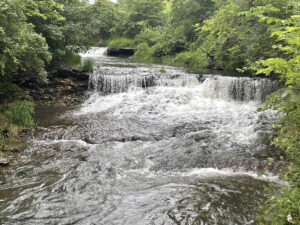
Tumbling waters
There it is! A Waterfall. There’s a second. Wow, just upstream is a third. Three waterfalls in one Iowa stretch of stream! How can that be in such a flat state?
Waterfalls bring mental images of water tumbling down steep hillsides where it plunges hundreds of feet downward. We’ve marveled at tall falls in many states including Hawaii, Nebraska, Washington, Indiana, Minnesota, New Hampshire, and New Jersey. But Rich had discovered the waterfall trio in an unexpected state – Iowa – and in an equally unexpected part of the state.
-
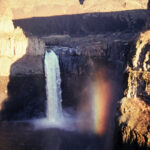
-
Water tumbles through a narrow cataract.
-
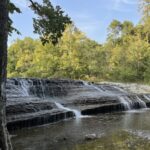
-
Indiana surprise
-
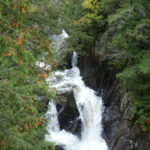
-
North Shore Falls
Briggs Woods County Park Delight
Amid north central Iowa’s vast level corn and bean fields he discovered the three cascades after a short hike near Webster City. More than rushing water caught his eyes. Fish were trying to leap up the rushing torrent. “It brought back memories of salmon leaping Brooks Falls in Alaska. These were small fish of an unknown species. Watching them was great fun,” he said. The three falls are close together in Hamilton County’s Briggs Woods Park and all it takes to enjoy them is a short hike on an easy trail.
Driftless Area
Iowa isn’t flat. Mostly it’s rolling terrain, but the state’s northeast corner features downright steep slopes. It’s the Driftless area, where most of Iowa’s falls gurgle and tumble down into clear running trout streams.
Touring Iowa’s Waterfalls
Seeing the Briggs Woods falls gave us a waterfall bug, so a few weeks later we drove north from our Cedar Rapids home. A region of Karst topography, the Driftless boasts dozens of clear water trout streams and several impressive falls.
-
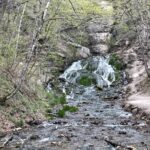
-
Karst topography helps create waterfalls.
-
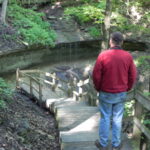
-
Bridal veil falls, at Pikes Peak
Decorah Area
Decorah is Iowa’s waterfall epicenter. Twin Springs bubbles quietly from the ground and flows down past a campground. Siewer’s and Dunnings Springs hurl an impressive amount of cool clear water over rocks close to downtown. (Note, the travel Iowa site uses an apostrophe (‘) for Siewer’s Spring but not for Dunnings). It’s easy to park close to all of these. Viewing nearby Malanaphy Springs is worth the mile walk. It’s the best known of several falls that send water to the Upper Iowa River.
-

-
Cooling waters.
-

-
Water tumbles from the ledges
-
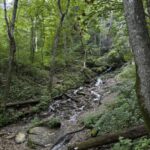
-
A popular stop for canoeists on the Upper Iowa River.
-
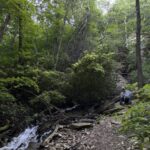
-
Hike through quiet woods.
Other Waterfalls
Other Waterfalls? Yup. Depending on who you ask and what you consider a waterfall, the Hawkeye state has dozens of them. Many aren’t natural waterfalls. Many are human-made cascades tumbling down a dam spillway, but the ones mentioned above are genuine nature-made falls.
Benefits of Seeking Out Waterfalls
We love falls for their beauty. Visiting them has a side benefit. They are in Iowa’s most beautiful terrain. A waterfall viewing trip gives the opportunity to see these unexpected Iowa sights, hike challenging trails, enjoy local eateries, and overnight in nearby campgrounds or one of the dozens of bed and breakfasts scattered about rural and small-town Iowa.
Where to Find Waterfalls
A helpful resource for finding falls is Travel Iowa – 14 Wonderful Waterfalls in Iowa.
by Winding Pathways | Jul 11, 2024 | Nature, Travel/Columns, Wonderment
Winding Pathways is near the edge of town, making it easy to drive into the country and enjoy rural views. Mostly our car traverses Iowa’s abundant corn and soybean fields, but two recent trips gave exceptional views of different vegetation that bloomed in bright lavender under the June sun.
The Lavender Farm
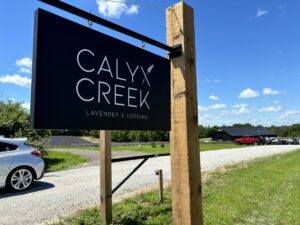
Entry to Calyx Creek
One recent June afternoon as we drove through conventional crops an amazing and delightful view appeared. Shades of purple and stunning white blanketed the undulating land accenting the deep green of cultivated crops. We had discovered Calyx Creek Lavender and Lodging a few miles west of North Liberty, Iowa. Rows of lavender in various stages of growth surrounded us as we entered the main building to find various products made of this unusual plant.
The warm, calming fragrance of the oils of this subtle herb wafted through the shop. Dried bunches hung from racks. Informational signs in front of gleaming machines shared highlights of the distillation process. Soaps, oils, candles, carpet freshener, lavender-infused stuffies and slippers, beverages, and tasty treats beckoned visitors to sample and buy. A lemonade mix was a hit among patrons on this warm summer day. “It smells so good inside, and this lemonade is super!” commented one man, cupping the cool drink in his hands.
-

-
An array of products awaits.
-

-
Slushys are popular.
Tours and Lodging
Part of the experience includes tours, opportunities to harvest and enjoy in your own home, and overnight lodging!
We walked among fields of blooming lavender to two of the several cabins available for rent. The two, built on pedestals, are well-equipped. All the lodgings offer a chance to “get away” while being close to nature. We climbed the stairs, sat on the small cabin’s deck, and took in the rural views of expansive fields of lavender. Peace flowed through us.
-
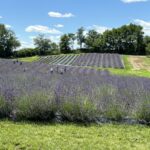
-
Strolling through lavender fields
-
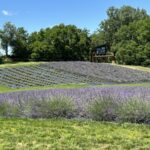
-
Peaceful overnights
Calyx Creek Lavender and Lodging is a fun place to visit, especially during the early summer blooming time. More information at: Calyx Creek LLC, 1722 255th St. NW, Oxford, IA 52322.
Phone: (319) 900-5992
Where Does Lavender Originate?
Lavender is native to the Mediterranean Region of southern Europe and Northern Africa. It has so many uses that it has been planted around the world. It has become problematic in Australia but is a valued product in North America. Lavender has a long, documented, and storied history with applications for improved health, reducing anxiety, moderating the effects of bug bites and burns, and as an antiseptic/anti-inflammatory agent. The latter is useful in the flu season. Gardeners can grow lavender at home. A helpful resource on how to grow it is at Garden Design.
More Rural Views
The fields of lavender at Calyx Creek are carefully groomed, providing a contrast to our discovery the next day. Secondary roads stairstep through Iowa, replete with rural views of corn, beans, oats, cattle, and goats. We were making our way to a reconstructed prairie south of Waterloo, Iowa
The Irvine Prairie
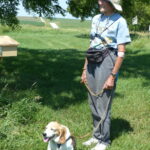
A happy duo.
That day Cathy Irvine led us through her prairie dotted with pale purple coneflowers, purple prairie clover, and blooms of different hues. Common yellowthroats serenaded us as red-winged blackbirds winged around this amazing place.
We admired the beauty of one of Iowa’s largest reconstructed prairies and were humbled to have Cathy Irvine share part of her day with us. Some people are so inspiring. She’s one.
After years of conventional farming, her vision took her land in a different direction. She’d turn the clock back and restore her land to how it looked and functioned before the first plow turned the original prairie into row crops. She didn’t do this on a whim. For decades Cathy had thought about, researched, attended programs on, and connected with experts on prairies. She knew that reconstructing the native habitat with its diverse plants and animals was right to do.
-
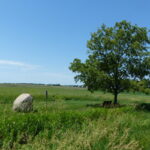
-
Glacial boulders are part of the landscape.
-
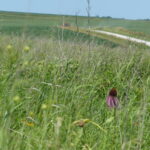
-
Contrast
Collaboration
Working with the Iowa Natural Heritage Foundation and the University of Northern Iowa Tallgrass Prairie Center she placed much of her farm in conservation easement and collaborated on restoring it to its native vegetation in honor of her late husband, David. Being in a conservation easement means that it will remain a wild and gorgeous prairie forever, no matter who might own the land in the future.
Iowa’s Rich Heritage
Iowa’s original prairie hosted upwards of 300 plant species on each acre that agriculture transformed into vast monocultures of soybeans and corn. Cathy’s land was in row crops until she decided to give her property to the Tallgrass Prairie Center under a conservation easement. Starting in 2018 the Prairie Center began planting upwards of 100 native species an acre and followed it up with prescribed burning, weeding, and even plugging in more native species.
Cathy, the Tallgrass Prairie Center, and the Iowa Natural Heritage Foundation welcome visitors to experience what much of Iowa once looked like. It’s a place to enjoy dancing prairie grasses and forbs on a breezy summer day, listen to birds trilling across the expanse, watch butterflies forage on blooms, and be inspired by the quiet beauty resulting from a transformation springing from Cathy’s vision and cooperative effort.
The Prairie is located at 1173 55th Street, Dysart, Iowa. Several mowed trails radiate outward from a small parking lot. A bench nestled under a spreading tree offers shade and a place to reflect.
-
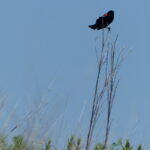
-
Calling out territory
-
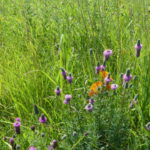
-
colorful forbs
-
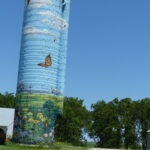
-
Colorful silo
Best Times To Enjoy Prairie Flowers
Prairie flowers bloom throughout the growing season but during midsummer’s heat, the colors are most amazing. However, the prairie is magical in any season. We enjoy our small reconstructed prairies through all seasons and especially in the summer months.
The Lavender Farm meticulously cultivates a useful plant not native to Iowa and the Irvine Prairie carefully stewards a rewilded prairie. Both are gorgeous.
For more information, visit the Tallgrass Prairie Center and the Iowa Natural Heritage Foundation websites.
The Color Purple
Our eyes had the good fortune to view purple lavender one day and purple prairie flowers the next, but purple is a tricky color, at least for some people. Like around 10% of men and boys, Rich isn’t able to see it or see it as folks with normal color vision can. “Red and shades of red are hard for me to see. Purple is nearly impossible. It seems odd but I can see the color but know it looks very different to me than to most folks. If someone asks me what purple looks like I have to say, I’m not sure since I can’t really see it,” he said. “Fortunately I can see blue and yellow prairie blooms and magnificent butterfly milkweed flowers that seem to glow a bright orange,” he added.
Winding Pathways encourages readers to take in any of their native habitat to appreciate our green island home – Earth.
by Winding Pathways | Apr 25, 2024 | Nature, Reflections/Profiles, Travel/Columns
The steep climb got us huffing and puffing until we crested the hill and looked around. Beneath us was a spacious pond and on the far hillside cattle grazed in the evening’s dwindling light. Oncoming darkness, combined with tired leg muscles, encouraged us to circle back to the historic farmhouse where we overnighted.
It sounds like a Montana adventure, perhaps at the spacious American Prairie, but it isn’t. We were at Iowa’s Whiterock Conservancy, a remarkable landscape just south of the tiny town of Coon Rapids in the west central part of Iowa.
What IS Whiterock Conservancy?
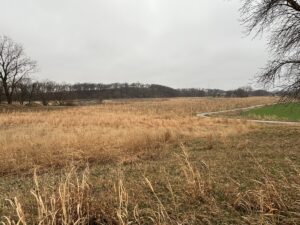
Bike or hike or ride your way along miles of intriguing trails.
Whitrock defies the norm in a state short on places big enough for outdoor enthusiasts who love spaciousness. Winding through its 5,500 acres are about 40 miles of trails that welcome hikers, mountain bikers, equestrians or folks just wishing to walk away from the noise and distractions of modern life. Whiterock is a place to enjoy the quiet and the dark sky of this lightly settled region.
There’s more. Whiterock Conservancy, named for an outcropping rising above a campground, is a testament to the formation of modern agriculture. Roswell Garst farmed the land and enthusiastically promoted hybrid corn. He was a force enabling the land to dramatically increase its production of food.
Entrepreneur, Ambassador, Visionaries
Garst was also an ambassador of sorts and invited his friend, Soviet Premier Nikita Khrushchev, to visit in 1959. The Russian was eager to find ways to expand his country’s food production. For a day the world came to the Garst Farm and Coon Rapids, Iowa. Dignitaries, reporters, and even some possible Soviet Spies were everywhere. The story is that one could tell the “spies” because, in this decidedly farm community, they were the only ones dressed in suits.
The Garst Family was visionary. Rather than sell their land for massive modern agriculture they encouraged the development of the land trust that combines agriculture and outdoor recreation in creative mosaics.
What’s There
After our walk and a picnic dinner, we settled down for the night in the old Garst Farmhouse, marveling at the collection of books, vintage furniture, and artifacts from Khrushchev’s visit inside. Its style was reminiscent of old-time New England homes – low ceilings, a newell post at the end of the stairs, wainscotting, tiled bathrooms, wallpapered ceilings, drapery on the windows, period cookware, and elegant teacups nestled in a corner cupboard. A swing-through door led to the well-equipped kitchen that looked out over a play yard and firepit. We could almost hear Roswell Garst talking up hybrid corn.
How It Came About
The Whiterock Conservancy was created as a nonprofit land trust about 20 years ago. Today it’s a progressive, innovative, and fascinating organization that combines agriculture, ecological restoration, lodging, and outdoor recreation spread over more than 5,000 acres.
We watched the cattle graze, listened as a flock of goats “baaahed” in anticipation of their dinner, drove miles of gravel roads through the property, and walked several trails. Perhaps our favorite was admiring the winter worn prairie grasses and forbs still standing sturdily in a brisk spring wind that rippled the pond’s water.
Things To Do at Whiterock Conservancy
Our short visit just whetted our appetite for the outdoors, and we plan to return. Here are some of many activities welcomed on the land:
-
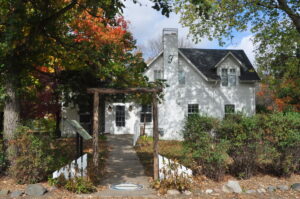
-
Period style farmstead that greeted Nikita Khrushchev. Photo Credit Whiterock Conservancy.
-
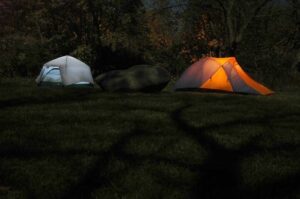
-
Tenting along the river. Photo credit Whiterock Conservancy.
-
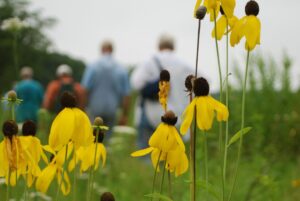
-
The Conservancy hosts a variety of programs. Photo credit Whiterock Conservancy
Camping: Several smallish and rather rustic campgrounds invite overnighters seeking quiet and gorgeous star viewing.
Trails: Well planned and maintained trails wind through hills, prairies, wetlands, and ravines. Hikers, equestrians, and mountain bikers are all welcome.
Home and cabins: Several indoor lodging options range from staying in one of many rooms in the historic farmhouse, to a nearby cottage. There’s even a walk-in cabin.
Activities: Staff and volunteers sponsor periodic programs to help visitors enjoy and appreciate nature and the Conservancy.
Fishing and Hunting: Visitors bearing an Iowa fishing license are welcome to try catching dinner from a dozen ponds scattered about the land. Check with headquarters about bowhunting.
Learn More and Visit!
The Whiterock Conservancy is a nonprofit land trust, funded by donations and grants. A list of fees and information is posted on their website. Donations are suggested for trail users and can be put in convenient boxes near trailheads. We so enjoyed the stay and visit with the staff.
by Winding Pathways | Jan 11, 2024 | Travel/Columns, Wonderment
What did I do yesterday morning? Did I make it to that meeting last Monday? Darn. I can’t remember. I’m forgetful. Fortunately, my journal writing isn’t.
18,250 days
Every day since April 1973 I’ve written a simple journal entry on small format lined binder paper. Haven’t missed a single day. Entries aren’t great writing and are rarely emotional. It’s not a diary. On some days I write only a few lines, while I might fill a page on more happening days.
My journal records about 18,250 days of my life. Combined notebooks take up about three feet of shelf space.
Uses of Journaling

Journals
Useful? Yup. When did we go to Yellowstone National Park? I remembered the month and year but not the dates. In minutes I found those dates in my notebook and learned what we did each day. What did we do on Christmas Eve 18 years ago? My journal reminds me.
My notes are simple, short, and often skip perfect grammar, but they are meant to bring every day into clear memory………so each journal entry records something distinctive about that day. Here’s a simple entry:
Monday, January 16, 2023: Weirdly warm with temperature in the 50s. Made new plywood shelves for my tool cabinet. Payton (a neighbor kid) was visiting when sirens blew warning of a potential tornado. We sheltered in the basement. No tornado here but one hit near Williamsburg, the first January tornado in Iowa since 1967.
Like Brushing Teeth
I’ve been journaling for so long it is as routine as brushing my teeth. Blank journal paper goes with me on trips, and I’ve even scribbled entries by lantern light at campgrounds.
My memory lapses. My journal never does.
What are Ways YOU Remember?
People have other ways to remember or “journal.” Share some and we can post on Winding Pathways
by Winding Pathways | Nov 16, 2023 | Nature, Travel/Columns
Lynyrd Skynyrd Tribute
“Sweet Home Alabama” by Lynyrd Skynyrd is a “heartfelt tribute to the state of Alabama.” Adopted by Alabama tourism as its slogan the “catchy” phrase indeed speaks to the variety and comfort of this truly Southern Hospitality state.
On a hot and muggy September trip to the deep South, we experienced Alabama hospitality and diversity from north to south.
Surprising Diversity
The northern third of Alabama is rugged where the Appalachian Mountains swing in from the northeast and finger down southwest toward the center of the state. The Tennessee River flows from Knoxville, TN, then cuts northwest through Huntsville and Decatur and on into the Tennessee Valley Authority. It’s wet there and tent camping is an adventure when the waters run high. We quickly learned that most of the waterways flow south and spill eventually into the Gulf. Planning our crossings was important because there are limited bridges from west to east.
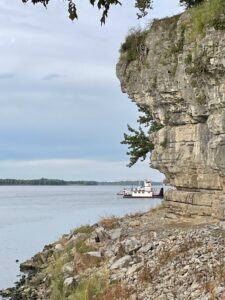
Quick way to cross the Ohio
Further north we did ferry across the Ohio at Cave in Rock, IL. This working ferry gets local and distance travelers across the broad river. The sounds of the ferry clanging and moaning of chains and engines at night recalled Jurassic Park! Then we wound our way through Kentucky and Tennessee to Alabama following parts of the Natchez Trace and the Trail of Tears.
Geologically, the ancient Appalachians of northern Alabama boast caverns, natural bridges, and tumbling waterways with falls. Cooler mountain air and vistas delight weary travelers’ eyes.
Birders find diverse birding from the endangered Red-cockaded Woodpecker that thrives in mature pine forests to the Bald Eagles that seem to soar everywhere nonplussed by humans. Nearer the coast migrating birds rest from their long flight over the Gulf. The State promotes varied birding trails.
Culturally, The Poarch Creek Indians hold Alabama sacred and are the only federally recognized Indian Tribe in the state. The Helen Keller home in Sheffield and Huntsville’s U.S. Space and Rocket Center are great stops.
This unusual phrase refers not to martial arts but to fertile calcareous soils that span central Alabama. Here, farming in plantations dominated. This region is also where the Civil Rights movement of the ‘60s. Montgomery hosts the new Legacy Museum that powerfully retells the story of kidnapped Africans who became slaves on plantations and the unjust, centuries-long suppression and incarceration of people. Along with The National Memorial for Peace and Justice, this important, interactive museum holds accountable past injustices and opens the door for reconciliation and cultural change where we ALL can be better people.
-
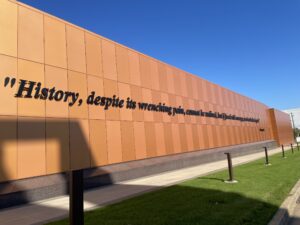
-
A sober and important museum of history.
-

-
Blend of new and old
The Coastal Shores
The drive through large swaths of timber-harvested pine forests revealed a source of the nation’s telephone poles. So, thank Alabama’s logging industry the next time you pass a pole. Our destination was Gulf Shores State Park and Lodge where we explored for three days. The Lodge is LEED certified and surrounding modern “cabins” and RV camping accommodate most budgets. How smart of the state to get this piece of Gulf land. It is one of the few areas not privately developed and with views of the Gulf waters. With miles of bicycle trails, fresh, brackish, and salt-water areas, and white sugar sand beaches, it is totally enjoyable. The habitat changes in a short distance depending on elevation (yes there is elevation along the coast) and proximity to the Gulf. We bicycled past freshwater ponds, palmetto areas, oak knobs, and back to beach habitat.
Lots for most people to take in. Our favorite was walking after dark along the shore looking for the ghost crabs. Herons stalked nearby, also on the hunt. Dawn found us sitting quietly along with others watching the sun rise over the Gulf. Each day crews set out and took in beach chairs and umbrellas. Flags flutter in strategic places alerting visitors to water conditions. During our stay, small yellow flags rippled in stiff winds. Rip currents are a thing to pay attention to.
-
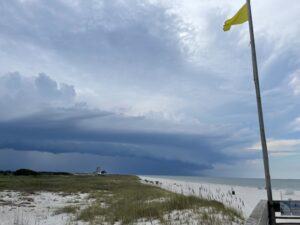
-
Weather changes rapidly along the Gulf.
-
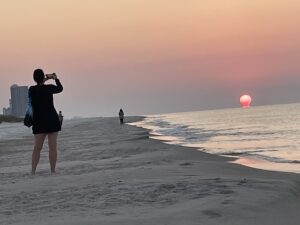
-
Quiet time at sunrise in Sweet Home Alabama
-
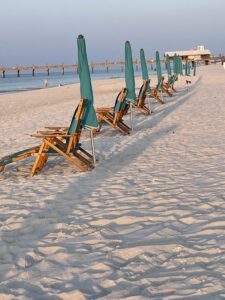
-
Ready for beach goers.
Rich took in a day fishing trip out of sight of land learning more about Gulf waters, sea bed, and the fishing industry. Marion took in oyster harvesting. Owners of Admiral Shellfish and Navy Cove shared the aquaculture techniques to raise oysters from pinpoint size to eating size in a matter of months. In northern waters, it’s years before edible oysters can be harvested. We both enjoyed several meals of oysters – who got the raw end of the deal!
-
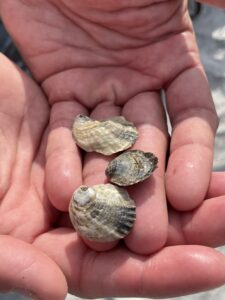
-
Gulf oysters
-
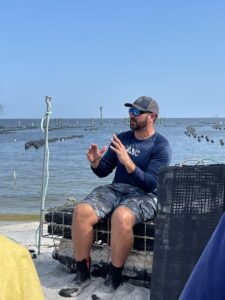
-
Protected waters make excellent habitat for oysters.
Lodging & FOOD!
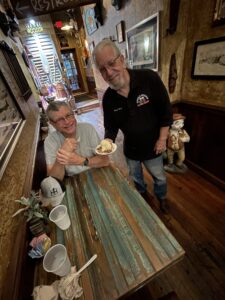
Uncle Mick’s Cajun old town Prattville is THE place to eat Southern.
We can’t say enough about Sweet Home Alabama hospitality and food. The front desk staff at the Hampton Inn and Suites, Prattville, AL, are some of the most friendly, efficient, and kind service workers we have ever met. They guided us to Uncle Mick’s Cajun just down the road in old town Prattville. The unique and tasty dishes and personal touches by the owner made the meal memorable. Staff kept dishing up small portions of truly Southern food for us to try and then loaded on our choices. Uncle Mick himself visited and drawled, “Would you like the pecan pie warmed up?” Well, yes. “How about a scoop of our local vanilla ice cream?” Well, yes. “And we’ll pour over warm bourbon sauce. If you’d like.” Well, YES! All at no extra charge. Amazing!
At Gulf Shores, the Flying Harpoon is truly local. Unpretentious, funky, and busy! Eating our po boys, and shrimp baskets, and sipping a local brew we chatted with servers and residents. Down the road tourists dined at the “recommended” upscale restaurants.
One of our most curious adventures was the luxury RV water park Tropic Falls at OWA. Not much natural there, but a great time watching huge buckets fill with water and splash down soaking nearby visitors. It was hot so that was fine! Tropical falls and dizzying roller coaster rides were two hits along with mermaids serving beverages and food. Quite the place. Be ready to spend money.
Back up through pine forests, skirting rivers, crossing the Ohio and Mississippi Rivers, and on into familiar Midwest terrain. We carry memories and stories with us.
by Winding Pathways | Nov 2, 2023 | Travel/Columns
West to Montana
This September, after a more normal Cedar Rapids year (post-derecho, post-COVID, post-surgeries) we headed to the American Prairie Reserve in Montana which we help support. Our compact equipment fit nicely in the Subaru as we headed out on Highway 30. That gave us a great view of wind turbines, especially in western Iowa. We threaded our way up to and through Sioux City to I-90 and crossed South Dakota, pausing at eye-catching rest stops.
The Badlands were smoky from Canadian wildfires the first night we camped but cleared some by the next morning. The spacious tent sites were pleasant, and our lifetime National Park senior passes came in handy.
-
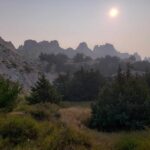
-
Canadian wildfire smoke.
-
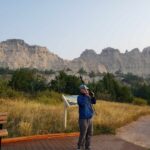
-
Smoke drifted off overnight.
-
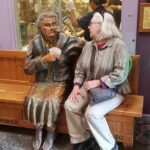
-
Author “visiting” with wooden Wall Drug statue.
We enjoyed the Badlands loop and then just had to stop at iconic Wall Drug and walk through without succumbing to the enticements. We didn’t get ice water but had coffee instead.
The Bighorns in Wyoming.
Such unusual names like Crazy Woman Creek and the Tongue River, had us speculating what might be behind those names. As we passed through the Crow Reservation we thought about the contrasts between Reservation land, with less arable soil, and non-Reservation lands and settlements. The Crow land is large. We noticed some fields with square bales compared to the large, round bales on non-reservation ranches.

The Bighorns loom in the distance.
The second night found us camping in a private campground in southeast Montana north of the reservation. Most private campgrounds are geared toward huge RVs and camping trailers, with few tent spaces. However, we secured a tent spot by a stream and enjoyed showers.
The land changed radically in Montana. Rocky hills with huge hayfields, grazing cattle, and beehives dominated. We saw some sorghum and sunflower fields.
-
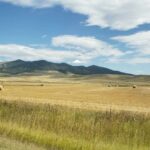
-
Montana is a mix of agriculture and steep hills.
-
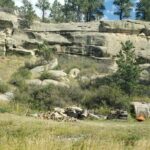
-
Tenting among rocks.
-
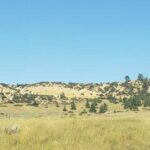
-
Montana’s varied landscape
American Praririe Reserve
We headed west and then north on US 191 to our cabin on the American Prairie Reserve (APR). Small cabins with bunk beds and storage space were seven miles north of the Missouri River. Although we have tent camped many times in bear and cougar country, we were glad to have a rustic cabin. Along with four cabins, there were also about twelve primitive camping sites. We cooked outside.
The well for potable water, with high mineral content, was 2,000 feet deep. We used community showers, toilets, two sinks, and a dishwashing sink/drainer which were very thoughtfully spaced and planned. By hiking trails near the cabins, we learned about prairie ecosystems – grasslands, soil and water, bugs, birds, and animals. As we hiked around the area, prairie dogs gave us hell every time, pipping like crazy. Plenty of scat and some bear paw prints confirmed we were glad to have a cabin to stay in.
-
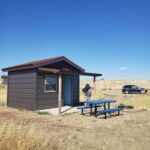
-
Several huts and rustic camp spots invited visitors.
-
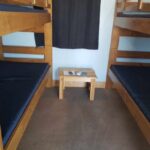
-
The tiny cabin kept us warm.
-
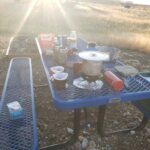
-
We cooked outside.
Little Rockies in the north in this photo. The Lewis and Clark Expedition thought they were the Rockies.
Other trails lace the Reserve. The Upper Missouri River Breaks are west and the Charles M. Russell Wildlife Refuge is south of the American Prairie Reserve with trails.
The evenings were delightful. Gorgeous sunsets glowed for hours. And in the dark sky, a jillion stars shone brightly. We saw constellations we hadn’t seen in years.
-
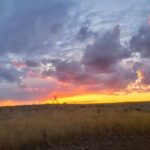
-
Sunsets linger in the open West.
-
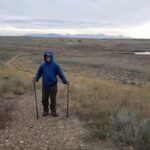
-
Beginning of the Rockies.
-
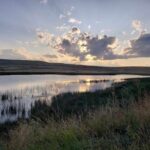
-
Birds flock to wetlands.
Munching in Malta Montana
We enjoyed the tiny, totally packed general store in Zortman hamlet. (3-4 of everything!) We circled the Bowdoin National Wildlife Refuge, a treasure of lakes and wetlands. Here is a sanctuary for resident and migratory birds, many new to us. The water in the area is managed to maintain the lakes and an abundance of artificial islands were established to protect the nesting birds from predators. Stretch’s Pizza in Malta, MT, offered up some of the best vegetarian pizza ever. A welcome change from camp food and one of only two restaurant meals of our trip. The comprehensive Phillips County Museum in Malta gave major space with empathetic attention to both Native people and settlers. Absolutely a not-to-miss stop. And, of course, there was Elvis, the dinosaur, so named because of its perfectly articulated hips, found near Malta.
-
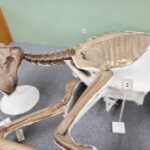
-
Montana houses many ancient artifacts.
-
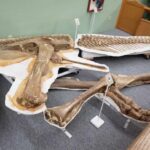
-
The hips swivel like Elvis
After three days at and near APR we headed up to US Highway 2 and Fort Peck. Again, our National Passes helped with expenses. A lovely camping spot below the dam along the Missouri River boasts trails in every direction.
Fort Peck
Fort Peck Dam is the largest hydraulic earth fill dam in the world, producing a billion kilowatts of electricity each year. You read it right, one billion. It was built in about seven years during the Great Depression but hydroelectric production didn’t get started until the early 1950s. It is 21,000 feet long.
-
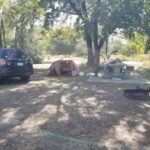
-
Trails radiate out from the campground.
-
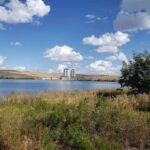
-
Billion kilowatt production
All along the Missouri River from the Breaks to Fort Peck area and around the reservoir is the Charles M. Russell Wildlife Refuge. It has sizable bison/buffalo herds. North of US Hwy 2 and east of the dam is the Fort Peck Indian Reservation where about 800 buffalo roam. We saw antelope, occasionally one but usually up to seven grazing in fields along with the cattle. American Prairie Reserve has the goal of preserving up to 300,000 acres of grassland in Montana which has one of only four sustainable grassland ecosystems in the world. The Reserve staff work with farmers to install wildlife-friendly fences, which have a more flexible, non-barbed wire on the bottom for antelope to cross under safely.
Into the Dakotas
Next, we headed east to North Dakota, and an unusually named town, Home on the Range. Every mile was a feast for the eyes as we drove through the Painted Canyon in Theodore Roosevelt National Park (TRNP) before heading to the south camping unit.
-
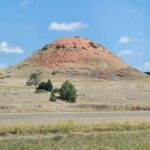
-
Western North Dakota sports splendid colors.
-
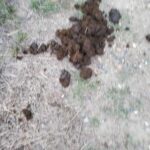
-
Animal droppings
-
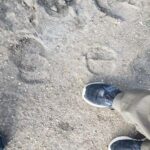
-
compare the sizes!
-
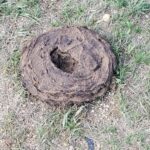
-
Bison make themselves known.
We managed to snag one of the last two camping spots. The wild horses, buffalo, antelope, and elk can all venture into the camping area. We saw evidence of the first two right near our camping spot. Five of the horses thought they might make a visit but campers steered them back into the wilds.
On our way to hike the Paddock Rim trail in the morning, we passed Sagamore Hill, Teddy Roosevelt’s Summer White House. Wild horses grazed in the distance. Bruce compared his foot size to buffalo hoof prints.
Prairie dog towns stretched as far as the eye could see in all directions. These chubby critters were grazing away, fattening up, and storing food for the winter as they do not hibernate. They were less wary than the ones on the American Prairie Reserve.
Agriculture and Open Range
As we drove through Montana, North Dakota, and northern South Dakota, I could not believe how many hay bales in fields and the enormous stacks and rows of bales we saw. We understand they had an unusually rainy summer and so the harvest was plentiful and they will be selling a lot of hay south. We also saw many cattle storm shelters on the ranches, and huge corners of metal or wood on the west and north for cattle to shelter if they get caught in the field during snowstorms. Here is a stock image of a shelter. The ones we saw were 2-4 times this big on a side to shelter a large herd and probably some wildlife, too.
-
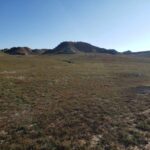
-
Prairie Dogs
-
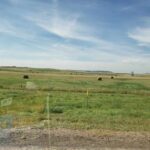
-
Enormous hay bales
-
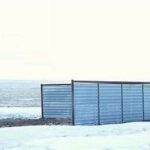
-
Cattle can huddle in the enclosures in bad storms.
Black Hills
On south to the Black Hills where we camped near Deadwood with the hills behind and mule deer in the campground.
The next day we circled lovely Sylvan Lake which was one of Bruce’s Aunt Gertrude’s favorite spots.
Having seen Rushmore several times with Gertrude, we chose the Needles Highway with plenty of crazy drivers.
Custer Park carefully maintains a herd of about 1400 buffalo so the land is not overgrazed. We visited the buffalo center and learned a mountain of new information and met “Bob” the buffalo.
-
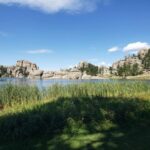
-
A favorite spot in the Black Hills
-
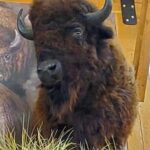
-
Custer State Park maintains a herd of bison
-
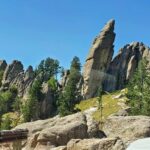
-
spires of the Needles Highway
We headed south to Wind Cave National Park to camp and saw buffalo coming down the hill as we ate supper. With an approaching storm perhaps they were heading to shelter.
Our camp was somewhat sheltered by a hill but we endured the most vivid storm with constant lightning and thunder, and pounding rain we have ever experienced in our tent. Not the windiest but certainly the loudest and most vivid. Obviously, we survived and surprisingly stayed dry. Running to the car would have been deadly.
-
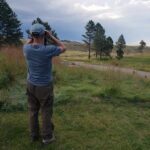
-
A fierce storm sent bison to shelter
-
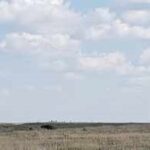
-
Bison
-
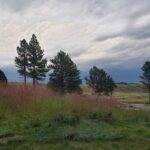
-
Storms kick up quickly in the west.
Our last camping spot before we headed to our farm was on the Niobrara River at Smith Falls State Park near Valentine, Nebraska. What a lovely night with the river rippling by. Smith Falls, is privately owned. However, the owner put in his will a permanent lease to the state so that visitors could experience this treasure. The hike and falls are quite stunning and the state has ensured that anyone can access this special place — totally handicapped accessible.
-
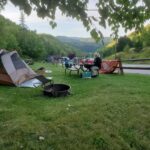
-
Most meals we prepared in camp.
-
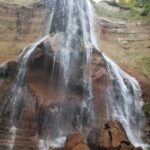
-
This private falls is open to the public.
-
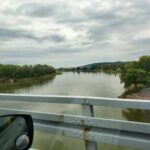
-
We followed and crossed the Missouri River many times.
So, we arrived back in Iowa, realizing we had seen many sections of the Missouri River along the way.



































































